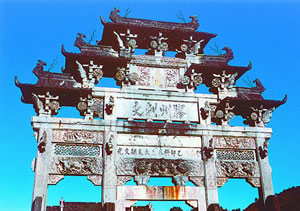 There is a saying popular among tour lovers: if you want to know about the lives of Chinese emperors, go to Beijing. The ancient city has an abundance of solemn palaces and magnificent gardens to dazzle your eyes.
There is a saying popular among tour lovers: if you want to know about the lives of Chinese emperors, go to Beijing. The ancient city has an abundance of solemn palaces and magnificent gardens to dazzle your eyes.
But if you want to see the ancient lifestyle of ordinary Chinese, go to Yixian County. This quiet and secluded county at the foot of picturesque Huangshan Mountain boasts some of the world's best-preserved ancient villages.
Most of them have been sitting there for more than 400 years. Despite the dramatic changes outside, they have peacefully maintained their old look. Even the local dialect is still the ancient one and remains unintelligible to those living just a few kilometers away in the neighboring counties.
The old dwelling houses, mostly built in the 16th century, are still firmly standing there, beaming at you from the shade of the green hills.
Land of Peach Blossoms
But if your tight schedule allows you only a brief visit, there is one village you'd better not miss - Xidi, the place acclaimed by tourists and scholars as one of the most beautiful villages in the world and a treasure house of traditional Chinese domestic architecture, which has just ensured its listing as a world heritage site.
Located in the southeastern corner of Yixian County, the village, like a big fish hooked from nearby hills, has another name - "The Land of Peach Blossoms", meaning a haven of peace in Chinese literature.
Xidi used to have no road linking it with the outside world. The only way in was by boat, making the countryside all the more peaceful and tranquil.
According to history books, men in Xidi used to be famous for their business instincts. After earning good money outside, they came back to their hometown and invested huge sums in building and decorating their houses.
This investment ensured the high quality of the houses, which has helped them survive all these years of erosion from rain and wind.
As most of the men were regularly away on business at that time, for the sake of security, they built tall walls around their courtyards, and didn't put windows in the houses. People got their natural light through the yard door.
Such a unique design formed a school of its own, known as huiju (Anhui Residence) in Chinese, one of the most famous architectural styles of the time.
On the corners of the houses you can see exquisite sculptures. Craftsmen carved flowers or other patterns symboling good wishes into the doors, adding to the elegance and beauty of the dwellings.
Of particular interest is an ancient building called Xiulou, with a gilded balcony overhanging the street.
Beautiful local women would dress up in ancient wedding gowns and throw colorful balls down to the crowds from the balcony. Those ones who were lucky enough to catch the balls would have the chance to win the girls' love, and perhaps be invited into Xiulou for an ancient wedding ceremony.
Of course, it was just a game for fun. Don't forget to have your friends take photos of you at this interesting moment.
Ancient Arches
Another famous scenic spot in the village is the paifang (meaning arch) of Hu Wenguang, an upright and honest official of the Ming Dynasty (1368-1644). The paifang was built in 1578, to commemorate this perfect official.
Although hundreds of years have passed, the characters and patterns carved into the stone can still be clearly seen. The open latticework and unswept roofline add to the elegance of the huge structure.
If you want to see more of this ancient Chinese architecture, just make a visit to the Paifang Village in nearby Shexian County, some 45 minutes drive from Xidi.
The village has the best examples of paifang. Eight to 10 ancient stone arches stand in a beautiful line, with each having a beautiful story behind them.
(China Daily November 25, 2002)
|

